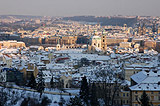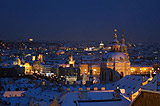500 Czech crown banknote
Feb 14, 17:52 Filed under culture
 On the 500 CZK banknote there is painted Czech authoress Bozena Nemcova. Her best known and widely read book is named Babicka, in English Grandmother, published in 1855. It is a book about her childhood and her happy memories of her kind and wise grandmother, describing country life in the Czech lands in the 19th century. Czech kids read this book in schools even today.
On the 500 CZK banknote there is painted Czech authoress Bozena Nemcova. Her best known and widely read book is named Babicka, in English Grandmother, published in 1855. It is a book about her childhood and her happy memories of her kind and wise grandmother, describing country life in the Czech lands in the 19th century. Czech kids read this book in schools even today.
Her life is from the very beginning shrouded in mystery – we don’t even know when she was born! Not even the year!! On her tombstone it says 1820 but her school records say 1818 or even further 1817! And the mystery remaines about her parents. Nemcova was born before her lawful parents – laundress and coachman for the duchess of Racibor, Katerina Zakanska – were married. So she was an illegitimate child. Since Nemcova was so different in appearance from these parents and the fact that she was allowed special privileges at the castle and was tutored there, the question is whether she wasn’t the illegitimate child of the duchess herself.
That is however not so important about her. The important thing is that she was a writer which was in her times quite unusual – woman and a writer. Back then writers were just among men. Using today’s words we would call her a feminist. She was breaking the ice also by trying to earn her living with her writing skills only which was, again, very bizarre. On the top of it, she wrote in Czech in a time when German was the number one language. It was not because she couldn’t speak German as she was well educated. She wrote in Czech because she believed that Czech was a nice language and should not be lost in favor of German.
She was very strong woman who was not afraid to challenge social and political attitudes if her time. On the other side of the banknote there is most likely a Muse.
See also Czech crown
 On the 200 CZK banknote there is Jan Amos Komensky, in English John Amos Comenius (1592-1670). Comenius was a Czech teacher, scientist, educator, writer and a protestant bishop. Because of his religion he was forced to leave Bohemia and therefore lived and worked in many different countries in Europe, and thus Comenius became known as the „Teacher of Nations“. He has been stamped the „Father of Modern Education“ since he came up with new ideas concerning teaching methods that we still use today.
On the 200 CZK banknote there is Jan Amos Komensky, in English John Amos Comenius (1592-1670). Comenius was a Czech teacher, scientist, educator, writer and a protestant bishop. Because of his religion he was forced to leave Bohemia and therefore lived and worked in many different countries in Europe, and thus Comenius became known as the „Teacher of Nations“. He has been stamped the „Father of Modern Education“ since he came up with new ideas concerning teaching methods that we still use today.  On the 100 CZK banknote there is Charles IV (1316-1378), Holy Roman Emperor and King of Bohemia who is regarded by Czechs as „Father of the Country“. Prague as it looks now owes a lot to him.
On the 100 CZK banknote there is Charles IV (1316-1378), Holy Roman Emperor and King of Bohemia who is regarded by Czechs as „Father of the Country“. Prague as it looks now owes a lot to him.  Starting with the banknote 50 CZK. Although a 50 coin is now taking over, the banknote is still widely available. There is portrayed St. Anezka Ceska, in English Agnes of Bohemia, who lived from 1211 to 1282. She is the patron saint of Bohemia and
Starting with the banknote 50 CZK. Although a 50 coin is now taking over, the banknote is still widely available. There is portrayed St. Anezka Ceska, in English Agnes of Bohemia, who lived from 1211 to 1282. She is the patron saint of Bohemia and  Let’s talk about money – it is always a juicy topic. But don’t worry I am not going to sing the famous song. I want to talk about the Czech currency – the Czech crown (koruna in Czech), abbreviated as Kč, internationally CZK.
Let’s talk about money – it is always a juicy topic. But don’t worry I am not going to sing the famous song. I want to talk about the Czech currency – the Czech crown (koruna in Czech), abbreviated as Kč, internationally CZK. 


 I am talking here about the exhibition of Jan Saudek, famous Czech art photographer. His work as well as his personality is celebrated, adored, worshiped by some people and at the same time vilified, despised and cursed by others. There is nothing in between.
I am talking here about the exhibition of Jan Saudek, famous Czech art photographer. His work as well as his personality is celebrated, adored, worshiped by some people and at the same time vilified, despised and cursed by others. There is nothing in between.  So what is typical for Czech food? Probably the most noticeable thing is that lunch is the main meal of the day in the Czech Republic. That is also why in restaurants food can be found for better price during lunch time (cca. from 11:30 a.m. to 2:30 p.m.) where you can have lunch with drink for less then 100 CZK – this of course doesn’t apply to restaurants right in the centre of Prague. Lunch consists of soup, main dish and sweet dessert or salad. Supper can be cold or warm, and it is less substantial than lunch.
So what is typical for Czech food? Probably the most noticeable thing is that lunch is the main meal of the day in the Czech Republic. That is also why in restaurants food can be found for better price during lunch time (cca. from 11:30 a.m. to 2:30 p.m.) where you can have lunch with drink for less then 100 CZK – this of course doesn’t apply to restaurants right in the centre of Prague. Lunch consists of soup, main dish and sweet dessert or salad. Supper can be cold or warm, and it is less substantial than lunch.  To name some traditional Czech main dishes – Roast pork with dumplings and sauerkraut; Fruit filled dumplings; Svickova – which is pork meat with dumplings and gravy, topped of with cranberry jam and cream; Chicken fried in breadcrumbs which is similar to a Wiener Schnitzel, usually served with boiled potatoes.
To name some traditional Czech main dishes – Roast pork with dumplings and sauerkraut; Fruit filled dumplings; Svickova – which is pork meat with dumplings and gravy, topped of with cranberry jam and cream; Chicken fried in breadcrumbs which is similar to a Wiener Schnitzel, usually served with boiled potatoes.